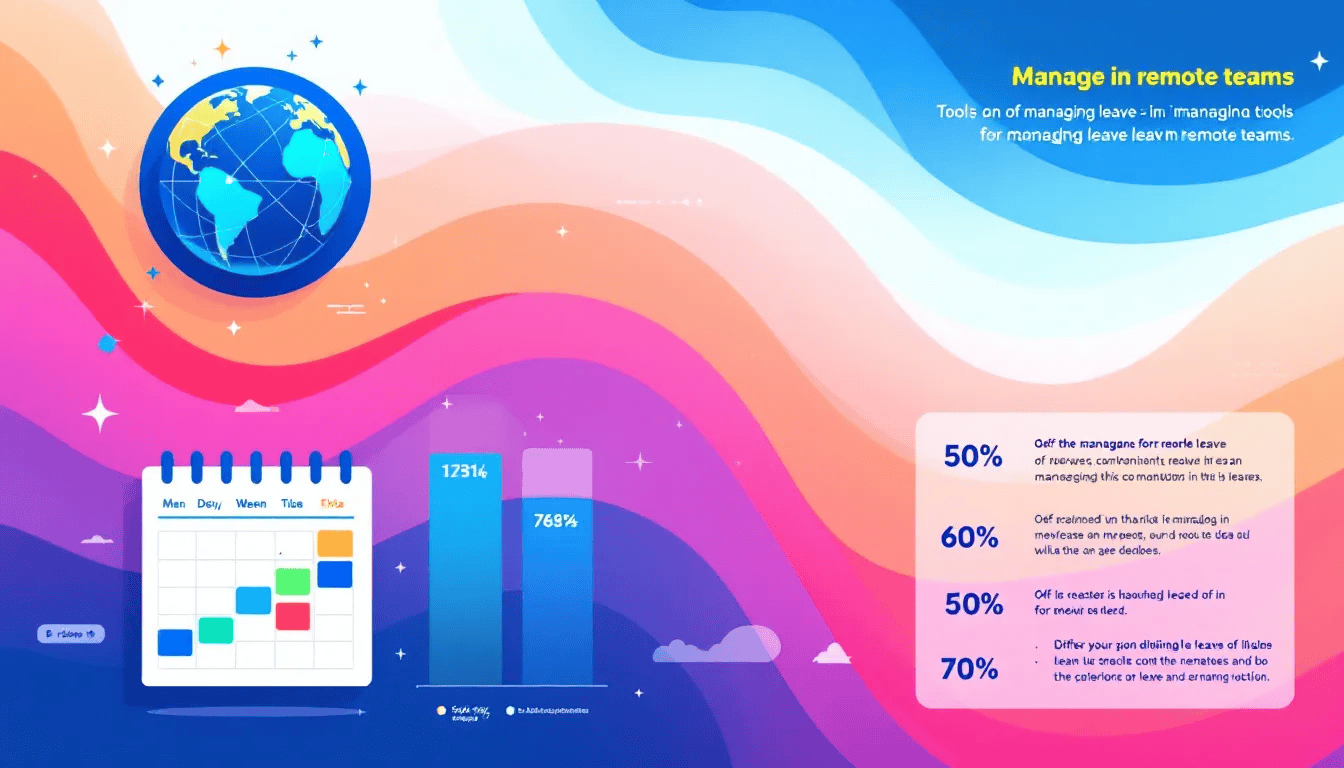Managing leave for remote workers requires clear policies that ensure fair treatment and compliance with labor laws. Remote work leave policies outline how remote employees can request and take time off, which is essential for maintaining productivity and employee well-being. This article covers the types of remote leave policies, their implementation, and best practices for managing leave in remote teams.
Key Takeaways
-
Remote work leave policies are crucial for equitable treatment and must be clearly defined, including types of leave such as annual, sick, maternity, and paternity leave.
-
Managing leave for remote teams requires effective communication and technology to track absences and ensure compliance with varying local labor laws.
-
Regular review and refinement of leave policies, along with utilizing dedicated PTO tracking tools, are essential for maintaining employee satisfaction and productivity in remote work environments.
Understanding Remote Work Leave Policies
Remote work leave policies ensure equitable treatment for employees working remotely. These policies can be categorized into fixed, flexible, and unlimited types based on organizational goals and employee needs. Fixed policies provide a set number of days for annual leave, sick leave, and other types of leave. Flexible policies allow employees to adjust their leave based on their workload and personal needs, while unlimited policies offer the freedom to take time off as needed without a cap.
Recognizing the various types of employee leave matters. Common types include annual leave, sick leave, maternity leave, paternity leave, and family responsibility leave. Annual leave, often referred to as holiday entitlement, is the time employees are allowed to take off for rest and relaxation. Sick leave is provided for employees who are ill and unable to work. Maternity and paternity leave support new parents, while family responsibility leave allows employees to attend to urgent family matters.
Managing leave for remote teams involves coordinating leave requests, ensuring compliance with labor laws, and addressing the unique challenges of remote work. Remote employees may face difficulties in taking time off due to the blurred lines between work and personal life. Thus, a clear annual leave policy outlining entitlements and procedures benefits remote employees. This helps prevent burnout and ensures that employees receive the rest they need to stay productive.
Challenges in leave management for remote employees often arise from the lack of physical presence. Without the ability to see colleagues face-to-face, it can be harder to track who is on leave and who is working. This can impact productivity and coordination within the team. Effective leave management involves using technology to streamline leave requests and approvals, ensuring that all team members are aware of their colleagues’ leave status.
Key Differences Between Remote and In-Office Leave Management
The transition from in-office to remote work has highlighted several key differences in leave management. In a physical office, colleagues can visually identify when someone is out on leave, making it easier to adjust workloads and maintain productivity. However, in a remote work environment, this visibility is lost. Colleagues may not know when a remote worker is on PTO, leading to potential miscommunications and workflow disruptions.
Tracking absence for remote employees is more challenging due to the lack of physical indicators. In an office, informal discussions about leave plans are common, allowing employees to coordinate their time off seamlessly. In contrast, remote work environments require formal communication channels to ensure everyone is informed about leave schedules. This necessitates clear expectations regarding remote work practices to prevent misunderstandings about attendance.
Additionally, compliance with local laws becomes more complex when managing leave for remote teams. Minimum leave requirements vary from country to country, and it is crucial to ensure that remote employees’ leave entitlements align with these regulations.
Effective leave management for remote teams involves adjusting workflows and technologies to accommodate virtual communication, ensuring that all employees, regardless of their location, are treated fairly and their leave requests are handled efficiently.
Creating a Comprehensive Remote Leave Policy
A comprehensive remote leave policy is essential for managing a remote workforce effectively. An effective Paid Time Off (PTO) policy should be developed with a focus on best practices and clear guidelines. Companies should set a standard policy while being flexible enough to adjust to individual cases, ensuring that the policy accommodates both remote and in-person employees.
Developing sound PTO policies for remote employees can be challenging but is feasible with the right approach. It is crucial to include procedures for submitting leave requests, ensuring that all employees receive fair leave entitlements, and considering the varying policies in different countries.
Continuous feedback from employees can help refine the policy and make it more effective in meeting the needs of remote teams.
Essential Elements of a Remote Leave Policy
Defining terms like ‘sick leave’ and ‘annual leave’ within the policy is crucial for clarity. This ensures remote employees understand their entitlements and maintains leave management consistency. Procedures for submitting leave requests should be outlined in detail to maintain consistency and transparency.
HR should ensure fair leave entitlements for remote employees, accounting for varying policies across countries. Clarifying whether entitlements are uniform or based on local laws is necessary. Providing a visual representation of leave policies can help remote employees better understand their entitlements and the procedures for requesting leave.
Continual feedback from employees can refine leave policies to better match the needs of remote teams. Gathering feedback during policy reviews can identify areas for improvement in leave management practices. This iterative process ensures that the leave policy remains relevant and effective.
Legal Considerations for Remote Leave Policies
Compliance with local labor laws is a critical aspect of remote leave policies. Remote employees are often entitled to the same types of leave as their in-office counterparts, including maternity and paternity leave. Employers must ensure that their leave policies comply with the minimum leave requirements of the countries where their remote employees are based.
Cross-border regulations can complicate the creation of leave policies for remote teams. Considering these regulations ensures remote employees receive their rightful entitlements. Additionally, employers need to consider the impact of bereavement leave on remote workers, ensuring they have the same access to support and time off as in-office staff.
Tools for Managing Leave in Remote Teams

The right tools can streamline leave management for remote teams. Leave management systems automate requests and approvals, enhancing transparency and clarity regarding leave policies among remote workers. Implementing an accessible leave management system can ensure that all team members are aware of their colleagues’ leave status, preventing miscommunications and workflow disruptions.
Various HR software options are available to manage leave effectively. CharlieHR is an all-in-one platform designed for managing time off without extensive supervision. Vacation Tracker integrates with platforms like Slack and Microsoft Teams, providing a seamless leave request experience. Calamari allows companies to set customizable leave policies suitable for globally distributed teams.
BambooHR offers mobile access for managing leave, making it convenient for remote employees. Timetastic provides a visual holiday tracker that helps teams manage time off more effectively. These tools can help HR managers and remote teams manage leave requests efficiently, ensuring that all employees receive their leave entitlements and that leave management processes are streamlined.
These tools help HR managers handle remote employees’ leave requests promptly and fairly, enhancing the overall process. This not only improves employee satisfaction but also helps maintain productivity and engagement within remote teams.
Best Practices for Leave Management in Remote Work
Best practices in leave management can significantly boost employee morale and job satisfaction in remote work. Flexible leave policies accommodate diverse employee needs, leading to higher retention rates. Effective PTO practices can boost employee morale and positively impact performance.
Balancing employee autonomy with performance expectations is a key element of effective leave management. Flexible work options can help reduce stress-related time off for remote employees.
Training managers to handle absenteeism issues effectively enhances their ability to support remote workers, promoting a culture where taking time off is normalized.
Encouraging Remote Employees to Take Time Off
Encouraging remote employees to take time off prevents burnout and ensures satisfaction. Addressing situations where staff feel pressured to work during leave can help remote employees better utilize their time off. Maintaining clear communication channels ensures that all team members are aware of when their colleagues are utilizing their PTO.
Managers should regularly use their PTO themselves to set a positive example and encourage remote employees to take time off. Self-management techniques can help remote employees streamline the process of requesting time off and encourage them to take their leave.
Promoting a culture where taking time off is normalized can lead to improved job satisfaction among remote employees.
Clear Communication of Leave Policies
Communicating leave policies clearly addresses information gaps remote workers face. Establishing clear communication channels within the remote leave policy ensures that employees understand how to request time off and are aware of their leave entitlements.
Managing Paid Time Off (PTO) for remote employees requires clear policies and good communication. Organizations should provide out-of-office guidelines to remote employees to help manage leave communications effectively. This ensures that all team members are informed about leave schedules, preventing miscommunications and workflow disruptions.
Regular Review and Update of Leave Policies
Regularly reviewing leave policies ensures they meet employee needs and comply with evolving legal standards. Regular reviews help maintain employee satisfaction and boost retention in a remote work environment. Establishing clear channels for employees to provide feedback on leave policies can help identify areas for improvement.
Using surveys or focus groups can be effective in gathering employee feedback on current leave policies. Leave policies should be adaptable to account for new workplace trends and challenges, such as those arising from remote work. Regular assessments ensure that the policies are current and aligned with the fluctuating needs of remote employees.
Addressing Absenteeism in Remote Work
Absenteeism refers to unplanned or unapproved absence from work duties. In remote work environments, this can become a significant issue. Having a well-defined absenteeism policy helps prevent surprises and aids in achieving work-life balance for remote workers. An absenteeism policy should specify acceptable reasons for absence, notification methods, and clear definitions of attendance or absenteeism.
Monitoring absenteeism for remote employees can be challenging due to methods being bypassed and privacy concerns. An effective approach involves focusing on performance metrics using HR tools that gather people analytics.
Implementing a structured return-to-work process helps identify patterns in absenteeism and any underlying health issues. Maintaining communication with employees on long-term sick leave is vital to ensure they provide necessary medical updates and remain engaged.
Impact of Specific Circumstances on Remote Leave Entitlement
Illness, caregiving responsibilities, and personal emergencies can significantly impact remote employees’ leave entitlements. These circumstances require adjustments in leave entitlements, highlighting the need for flexibility in managing remote work.
Remote employees need to be aware of their rights and entitlements under specific circumstances for effective leave management.
Handling Sickness During Remote Work
Clear policies for handling sickness during remote work help employees understand their rights and obligations. Employees can self-certify their sickness for the first seven days, after which a doctor’s note is required for any extended leave. This policy helps maintain transparency and ensures that employees take the necessary time off to recover without feeling pressured to work while ill.
Employers should clearly outline statutory sick pay entitlements in their remote work policies to ensure compliance and support for their employees. By having defined procedures and entitlements, remote workers can feel secure in their roles and know that their health and well-being are prioritized.
Clear sickness policies maintain productivity by ensuring sick employees do not work while ill, even remotely.
Parental and Bereavement Leave for Remote Workers
Parental and bereavement leave in remote work policies provide support during significant life events and fall under the statutory annual leave laws. Many remote work policies grant parental leave rights, which include provisions for both maternity and paternity leaves to support new parents. Ensuring compliance with applicable labor laws that govern parental and bereavement leave is essential to provide adequate support for remote employees.
Clearly communicating these leave policies informs remote employees of their entitlements, enhancing their ability to utilize benefits. By having well-defined and communicated policies, remote workers can plan for these significant life events without the added stress of uncertainty about their leave entitlements.
Implementing PTO Tracking Systems for Remote Teams
Accurate PTO tracking systems maintain staffing levels, prevent disputes, and avoid confusion among remote employees. Inaccurate PTO balances can cause unnecessary problems, affecting both employee satisfaction and operational efficiency. Therefore, utilizing a time-off management tool can address shortcomings inherent in remote-worker PTO policies.
A good PTO tracking system specifically benefits remote teams by addressing various challenges associated with remote work. When selecting PTO tracking tools, it’s important to consider several factors. These include cost, features, ease of use, and integration capabilities. Tools like BambooHR, CharlieHR, and Vacation Tracker can be highly effective in ensuring accurate and transparent PTO tracking.
These tools assist HR managers in manage PTO and ensure remote employees are aware of their available time off. Implementing a robust PTO tracking system enhances leave management processes and promotes a healthy work-life balance for remote employees.
Case Studies of Successful Remote Leave Policies
Effective leave management practices can significantly improve employee engagement. For example, a global tech company introduced a flexible leave policy that allowed remote employees to take time off as needed, leading to higher job satisfaction and reduced turnover rates.
Another company used a structured leave policy to ensure compliance with local labor laws while providing additional support for remote employees during significant life events. These case studies demonstrate that investing in structured leave policies not only benefits employees but also positively impacts organizational performance.
Prioritizing effective leave management fosters a supportive and productive work environment, leading to higher employee engagement and success.
Summary
In summary, navigating remote work leave policies involves understanding the unique challenges of remote leave management, creating comprehensive policies, and utilizing the right tools and best practices. Ensuring compliance with local labor laws, encouraging employees to take time off, and regularly reviewing and updating leave policies are crucial steps in maintaining a supportive remote work environment.
By implementing these strategies, organizations can enhance employee satisfaction, reduce burnout, and improve overall productivity. As remote work continues to evolve, staying proactive in managing leave policies will help companies build a resilient and engaged remote workforce.
Frequently Asked Questions
What are the key components of a remote leave policy?
A remote leave policy should clearly define leave types, outline procedures for submitting requests, ensure compliance with local labor laws, and incorporate mechanisms for continuous feedback. These components are essential for effective management and clarity for all employees.
How can companies track PTO for remote staff members effectively?
To effectively track PTO for remote staff, companies should utilize HR software tools such as BambooHR, CharlieHR, or Vacation Tracker, which automate and streamline the process. This ensures accuracy and ease in managing employee time off.
Why is it important to encourage remote workers to take time off?
Encouraging remote staff to take time off is crucial as it helps prevent burnout and enhances job satisfaction, ultimately fostering a healthier work-life balance. Prioritizing such practices can lead to a more engaged and productive workforce.
How do legal considerations impact remote leave policies?
Legal considerations are vital in shaping remote leave policies, as they ensure compliance with local labor laws and entitlements for remote workers. This adherence protects both employee rights and the organization from potential legal repercussions. Public holidays and bank holidays should also be taken into consideration for any allowance being provided.
What are some best practices for managing leave in remote work settings?
Adopting flexible leave policies and ensuring clear communication are essential best practices for managing leave in remote work settings. Regularly reviewing policies and utilizing technology for efficient management further enhances the process.




